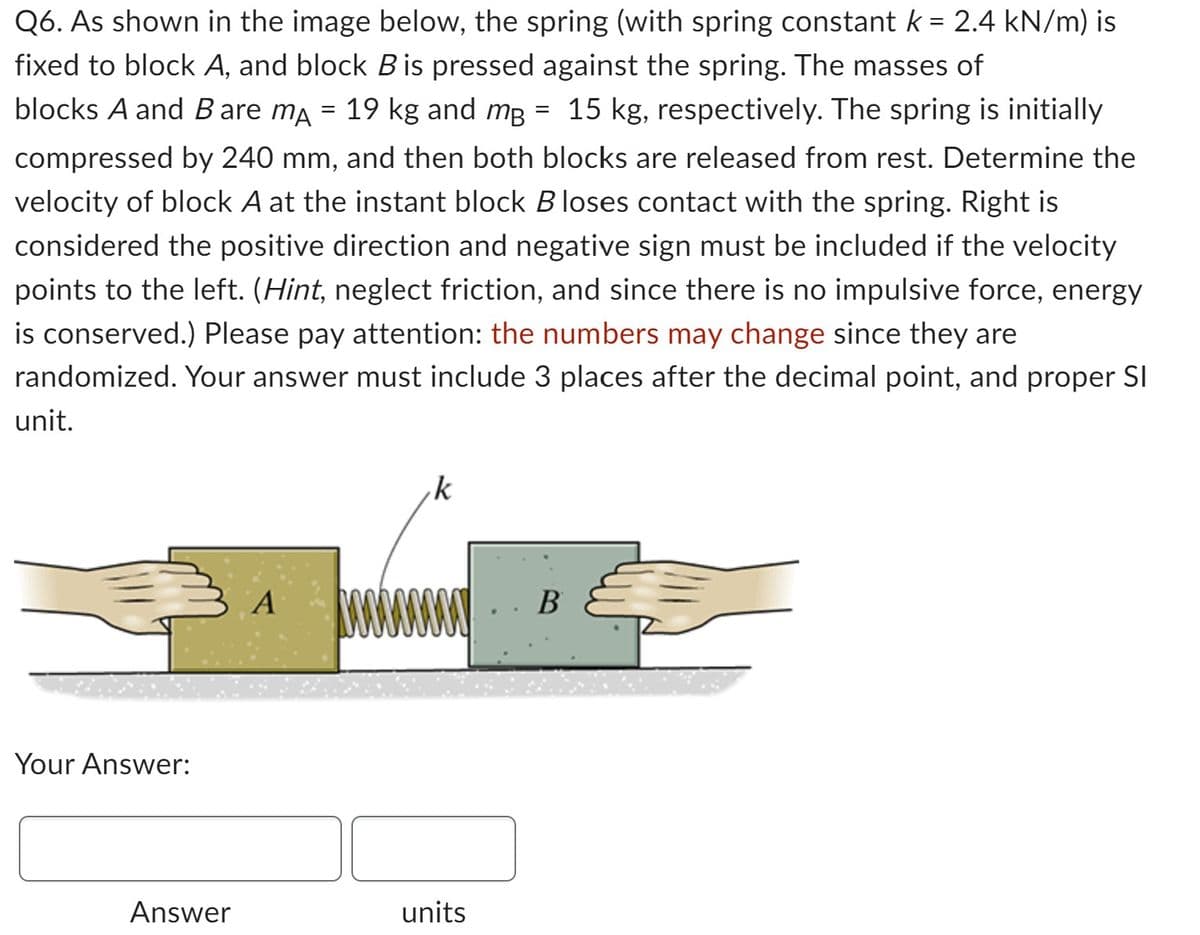Q6. As shown in the image below, the spring (with spring constant k = 2.4 kN/m) is fixed to block A, and block B is pressed against the spring. The masses of blocks A and B are mà = 19 kg and m² = 15 kg, respectively. The spring is initially compressed by 240 mm, and then both blocks are released from rest. Determine the velocity of block A at the instant block Bloses contact with the spring. Right is considered the positive direction and negative sign must be included if the velocity points to the left. (Hint, neglect friction, and since there is no impulsive force, energy is conserved.) Please pay attention: the numbers may change since they are randomized. Your answer must include 3 places after the decimal point, and proper SI unit. Your Answer: k B
Q6. As shown in the image below, the spring (with spring constant k = 2.4 kN/m) is fixed to block A, and block B is pressed against the spring. The masses of blocks A and B are mà = 19 kg and m² = 15 kg, respectively. The spring is initially compressed by 240 mm, and then both blocks are released from rest. Determine the velocity of block A at the instant block Bloses contact with the spring. Right is considered the positive direction and negative sign must be included if the velocity points to the left. (Hint, neglect friction, and since there is no impulsive force, energy is conserved.) Please pay attention: the numbers may change since they are randomized. Your answer must include 3 places after the decimal point, and proper SI unit. Your Answer: k B
Elements Of Electromagnetics
7th Edition
ISBN:9780190698614
Author:Sadiku, Matthew N. O.
Publisher:Sadiku, Matthew N. O.
ChapterMA: Math Assessment
Section: Chapter Questions
Problem 1.1MA
Related questions
Question

Transcribed Image Text:Q6. As shown in the image below, the spring (with spring constant k = 2.4 kN/m) is
fixed to block A, and block B is pressed against the spring. The masses of
blocks A and B are mà = 19 kg and m² = 15 kg, respectively. The spring is initially
compressed by 240 mm, and then both blocks are released from rest. Determine the
velocity of block A at the instant block B loses contact with the spring. Right is
considered the positive direction and negative sign must be included if the velocity
points to the left. (Hint, neglect friction, and since there is no impulsive force, energy
is conserved.) Please pay attention: the numbers may change since they are
randomized. Your answer must include 3 places after the decimal point, and proper SI
unit.
Your Answer:
Answer
A www
k
units
B
Expert Solution
This question has been solved!
Explore an expertly crafted, step-by-step solution for a thorough understanding of key concepts.
Step by step
Solved in 3 steps with 3 images

Knowledge Booster
Learn more about
Need a deep-dive on the concept behind this application? Look no further. Learn more about this topic, mechanical-engineering and related others by exploring similar questions and additional content below.Recommended textbooks for you

Elements Of Electromagnetics
Mechanical Engineering
ISBN:
9780190698614
Author:
Sadiku, Matthew N. O.
Publisher:
Oxford University Press

Mechanics of Materials (10th Edition)
Mechanical Engineering
ISBN:
9780134319650
Author:
Russell C. Hibbeler
Publisher:
PEARSON

Thermodynamics: An Engineering Approach
Mechanical Engineering
ISBN:
9781259822674
Author:
Yunus A. Cengel Dr., Michael A. Boles
Publisher:
McGraw-Hill Education

Elements Of Electromagnetics
Mechanical Engineering
ISBN:
9780190698614
Author:
Sadiku, Matthew N. O.
Publisher:
Oxford University Press

Mechanics of Materials (10th Edition)
Mechanical Engineering
ISBN:
9780134319650
Author:
Russell C. Hibbeler
Publisher:
PEARSON

Thermodynamics: An Engineering Approach
Mechanical Engineering
ISBN:
9781259822674
Author:
Yunus A. Cengel Dr., Michael A. Boles
Publisher:
McGraw-Hill Education

Control Systems Engineering
Mechanical Engineering
ISBN:
9781118170519
Author:
Norman S. Nise
Publisher:
WILEY

Mechanics of Materials (MindTap Course List)
Mechanical Engineering
ISBN:
9781337093347
Author:
Barry J. Goodno, James M. Gere
Publisher:
Cengage Learning

Engineering Mechanics: Statics
Mechanical Engineering
ISBN:
9781118807330
Author:
James L. Meriam, L. G. Kraige, J. N. Bolton
Publisher:
WILEY